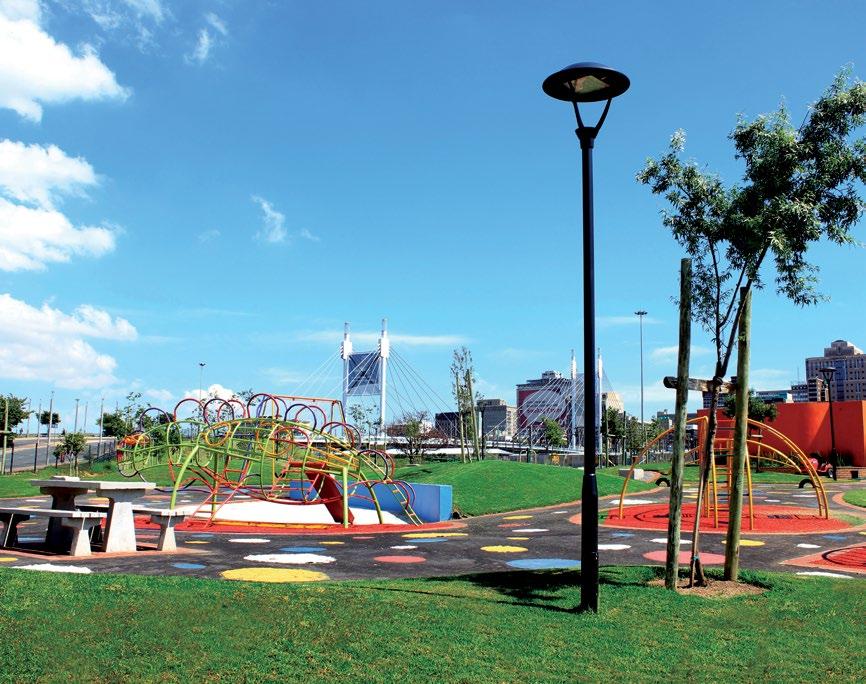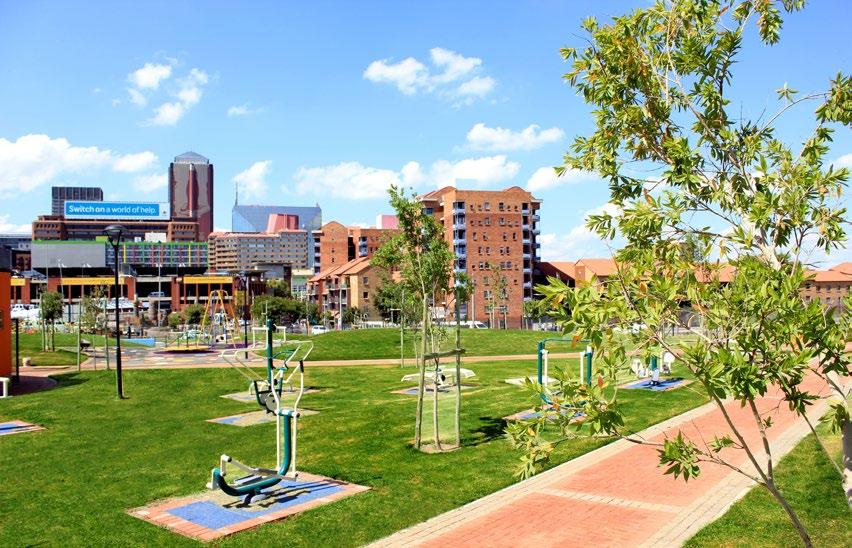
6 minute read
PROFILE Johannesburg City Parks and Zoo
End Street North Park’s
lessons for Africa
Advertisement
City officials globally are learning that residents’ quality of life is significantly affected by the quality of public open spaces available. A sociable, cohesive and healthy society requires well-managed and maintained public open spaces.
With 3 000 land parcels stretching from cemeteries to large road islands on its books, how does Johannesburg City Parks and Zoo (JCPZ) ensure the safety and upkeep of these parks and public open spaces with limited resources, budget and capacity to deal with the many challenges they face?
While focusing on limited resources to developing and managing accessible, inclusive and sustainable public open spaces. JCPZ found that lack of security and other concerns kept people away from local parks. End Street North Park in Doornfontein was selected as the most challenged site of a 2019 pilot project to make parks safe and attractive by testing alternative development and management concepts. The approach aimed to be holistic and collaborative, involving not only the local users and stakeholders, but also City departments. The overall ambitious aim was to develop a practical and integrated model to design and manage public open spaces that could be mimicked elsewhere in Joburg, and throughout cities in Africa.
Taken from the report Transforming Public Parks into Safe and Inclusive Community Spaces: Lessons on collaboration and participation from the City of Johannesburg, here are seven lessons learnt for park users and administrators throughout Africa.
1. More than just green spaces, parks knit neighbourhoods’ social fabric
Parks are more than simply physical spaces for relaxing and playing and require more input than the simple municipal services of picking up litter and cutting grass. A holistic understanding of managing public open spaces and parks is required for them to fulfil functions that best benefit the communities that use them, especially in dense and diverse neighbourhoods.
2. Partnerships and collective action are key to any park’s success
The ongoing process of activating and managing parks needs partnerships, networks and forums to germinate and take root. Adding capacity and knowledge-sharing to the park through the commitment of invested individuals with a common purpose make the adage ‘many hands make light work’ a reality.
The End Street North Park project was made possible through a joint partnership between Johannesburg City Parks and Zoo (JCPZ), as project leader, the Johannesburg Development Agency (JDA), the Department of Public Safety, Sticky Situations, Wits University and the Inclusive Violence and Crime Prevention Programme (VCP), a joint development cooperation programme between South Africa and Germany implemented by the Deutsche Gesellschaft für Internationale Zusammenarbeit (GIZ) and UNHabitat Global Public Space Programme . The process created the space for new collaborations to emerge, not only across City departments but with the South African Cities Network and the South African Local Government Association.

3. Park users are not all the same
Park users reflect the demographics of the neighbourhood plus school children and visitors. Therefore, a requirement to develop inclusive, safe and accessible parks is an understanding of the needs, desires and challenges of all different park users. Importantly, the roles of vulnerable groups such as people experiencing homelessness, waste collectors, informal traders provide by being the eyes and ears of the park, and as such contribute to safety and security. The needs of most park users can be accommodated through communication, education and negotiation about the role and contribution of the shared space to the general community, including how and when it is used.
4. Park safety is multi-dimensional and more than policing
A safety audit needs to be done. This will identify issues in the park and the surrounding precinct by mapping crime and give insight into how the space functions. Just as safety permeates every aspect of social life, public open spaces or parks cannot be isolated from surroundings, broader communities and managed effectively if the broader neighbourhood is unsafe. More than fences, security guards, and CCTV, safety also includes promoting social control by activating spaces through community engagement and supporting the implementation of rules and regulations and better communication and coordination among institutions.
In the case of End Street North Park, the audit highlighted external safety issues, such as the lack of a safe pedestrian crossing across a busy adjacent street, despite the presence of a nearby primary school. Another was the lack of toilets in the park, which contributed to people urinating in public. These reinforced perceptions that the park was dirty and dangerous, and a place in which, especially women and children, did not feel comfortable or safe.
5. Meaningful stakeholder engagement takes time and skill
Public participation is not simply a few casual consultations – it requires continuity and building trust between park users and government through a sustained process of communication, negotiation, respect and honesty. It also requires being vulnerable to making mistakes. Meaningful engagement does not happen through officials attending community meetings to disseminate information, rather it happens when active participants develop relationships.
The case study illustrated that for suitably effective levels of engagement, officials were required to work flexible hours and be given the opportunity to develop the ‘soft’ skills of listening and facilitation to properly understand people’s needs, desires and challenges. It also became clear that neighbourhood politics is integral to all participatory processes and cannot be ignored as this would lead to tension between different user groups, such as local users from different areas or with different political allegiances. These tensions are typically expressed in distrust, anger, alienation, and division which slows the project progress. Introducing all stakeholders upfront, including residents, local councillors and officials starts a transparent and communication-orientated process.
6. Leadership with a win-win approach
Committed leadership from the City is needed to coordinate regular engagement and build a dedicated park committee prepared to make the case for and to work across internal City departments, despite systems which discourage integrated approaches to annual activities, tasks or budgets. A project like the End Street North Park is a multi-year project involving local level politicians at a small scale.
What helps is to encourage a cross-sector response by presenting a win-win situation – the various officials must see that actively participating will contribute to achieving their own departmental targets.
7. Community buy-in and support makes the work easier and sustainable
Communities that have a sense of ownership, take care of the public open spaces they use. This care is often implemented after users with sometimes divergent interests agree to work together, and this cooperation is accelerated when officials effectively manage community expectations by sharing information on how the City works, helping them to shift from complaining to joint problem-solving.
Park users and local residents are key resources to any park development and when empowered to take responsibility of their own parks and public open spaces, they become more likely to contribute to ensuring that their spaces remain safe, secure, clean and functional. This ultimately makes the City’s work easier, especially in a resource-constrained environment. Starting small, a shared commitment mobilises greater levels of collaboration, which encourages resource mobilisation and promotes working together across City departments and with local ward councillors, as a virtuous cycle is catalysed.
WHAT IS PLACEMAKING?
Placemaking is an approach to designing, developing, activating and maintaining public open spaces that is based on community-driven and research-based processes. Collaborative community participation is at the forefront of creating public open spaces, inviting local users to collectively reimagine and reinvent public open spaces in which they are active. Collaborative engagement is used to shape the public realm, strengthen connection between local users and public open spaces that they share.
With community-based participation at the centre, effective placemaking processes recognise communities as resources and capitalise on local assets and potential. It is an immensely powerful way of approaching public open spaces. Genuine placemaking is when people of all ages, abilities and socio-economic backgrounds can, not only access and enjoy a place, but also play a key role in identifying, creating and maintaining it. Placemaking is a catalyst for pulling in investment for the economic growth of an area and for bringing communities together to improve their neighbourhood spaces. This results in more ‘eyes on the street’, which contributes to making places safer.







